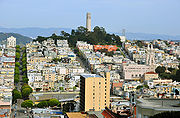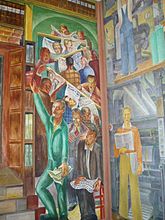Coit Tower
Coit Memorial Tower | |
 Coit Tower with statue of Columbus in foreground | |
| Location | 1 Telegraph Hill Blvd., San Francisco, California |
|---|---|
| Area | 1.7 acres (0.69 ha) |
| Built | 1933 |
| Architect | Brown, Arthur Jr. |
| Architectural style | Art Deco |
| NRHP reference No. | 07001468[1] |
| SFDL No. | 165 |
| Significant dates | |
| Added to NRHP | January 29, 2008 |
| Designated SFDL | 1984[2] |

Coit Tower, also known as the Lillian Coit Memorial Tower, is a 210-foot (64 m) tower in the Telegraph Hill neighborhood of San Francisco, California. The tower, in the city's Pioneer Park, was built in 1933 using Lillie Hitchcock Coit's bequest to beautify the city of San Francisco; at her death in 1929 Coit left one-third of her estate to the city for civic beautification. The tower was proposed in 1931 as an appropriate use of Coit's gift. It was added to the National Register of Historic Places on January 29, 2008.[1]
The art deco tower, built of unpainted reinforced concrete, was designed by architects Arthur Brown, Jr. and Henry Howard, with fresco murals by 27 different on-site artists and their numerous assistants, plus two additional paintings installed after creation off-site. Although an apocryphal story claims that the tower was designed to resemble a fire hose nozzle[3] due to Coit's affinity with the San Francisco firefighters of the day, the resemblance is coincidental.
History
Coit Tower was paid for with money left by Lillie Hitchcock Coit, a wealthy socialite who loved to chase fires in the early days of the city's history. Before December 1866, there was no city fire department, and fires in the city, which broke out regularly in the wooden buildings, were extinguished by several volunteer fire companies. Lillie Coit was one of the more eccentric characters in the history of North Beach and Telegraph Hill, smoking cigars and wearing trousers long before it was socially acceptable for women to do so. She was an avid gambler and often dressed like a man in order to gamble in the males-only establishments that dotted North Beach. Coit was reputed to have shaved her head so her wigs would fit better.
Lillie's fortunes funded the monument four years following her death in 1929. She had a special relationship with the city's firefighters. At the age of fifteen she witnessed the Knickerbocker Engine Co. No. 5 in response to a fire call up on Telegraph Hill when they were shorthanded, and threw her school books to the ground and pitched in to help, calling out to other bystanders to help get the engine up the hill to the fire, to get the first water onto the blaze. After that Lillie became the Engine Co. mascot and could barely be constrained by her parents from jumping into action at the sound of every fire bell. After this she was frequently riding with the Knickerbocker Engine Co. 5, especially so in street parades and celebrations in which the Engine Co. participated. Through her youth and adulthood Lillie was recognized as an honorary firefighter.
Her will read that she wished for one third of her fortune, amounting to $118,000,[4] "to be expended in an appropriate manner for the purpose of adding to the beauty of the city which I have always loved."[5] Two memorials were built in her name. One was Coit Tower, and the other was a sculpture depicting three firemen, one of them carrying a woman in his arms. Lillie is today the matron saint of San Francisco firefighters.[6]
The San Francisco County Board of Supervisors proposed that Coit's bequest be used for a road at Lake Merced. This proposal brought disapproval from the estate's executors, who expressed a desire that the county find "ways and means of expending this money on a memorial that in itself would be an entity and not a unit of public development."[4] Supervisor Herbert Fleishhacker suggested a memorial on Telegraph Hill, which was approved by the estate executors. An additional $7,000 in city funds were appropriated, and a design competition was initiated. The winner was architect Arthur Brown, Jr, whose design was completed and dedicated on October 8, 1933.[4] The tower took five years to construct.
Coit Tower was listed as a San Francisco Designated Landmark in 1984[2] and on the National Register of Historic Places in 2008.[1] Although Coit Tower is not technically a California Historical Landmark yet, the state historical plaque for Telegraph Hill is located in the tower's lobby, marking the site of the original signal station.[7]
Coit Tower was featured in the 1998 film, Doctor Dolittle starring Eddie Murphy. The tower appears in the first scene with the tiger (voiced by Albert Brooks) who contemplates suicide by jumping from the tower but is dissuaded from doing so by Dolittle.
Design
Brown's competition design envisioned a restaurant in the tower, which was changed to an exhibition area in the final version. The design uses three nesting concrete cylinders, the outermost a tapering fluted 180-foot (55 m) shaft that supports the viewing platform. An intermediate shaft contains a stairway, and an inner shaft houses the elevator. The observation deck is 32 feet (9.8 m) below the top, with an arcade and skylights above it. A rotunda at the base houses display space and a gift shop.[4]
Murals
The Coit Tower murals were done under the auspices of the Public Works of Art Project, the first of the New Deal federal employment programs for artists. Ralph Stackpole and Bernard Zakheim successfully sought the commission in 1933, and supervised the muralists, who were mainly faculty and students of the California School of Fine Arts (CSFA), including Maxine Albro, Victor Arnautoff, Ray Bertrand, Rinaldo Cuneo, Mallette Harold Dean, Clifford Wight, Edith Hamlin, George Harris, Otis Oldfield, Suzanne Scheuer, Hebe Daum and Frede Vidar.[8]
The artists were committed in varying degrees to racial equality and to leftist and Marxist political ideas strongly expressed in the paintings. Bernard Zakheim's "Library" depicts fellow artist John Langley Howard crumpling a newspaper in his left hand as he reaches for a shelved copy of Karl Marx's Das Kapital with his right. Workers of all races are shown as equals, often in the heroic poses of Socialist realism, while well-dressed racially white members of the capitalist classes enjoy the fruit of their labor. Victor Arnautoff's "City Life" includes The New Masses and The Daily Worker periodicals in the scene's news stand rack; John Langley Howard's mural depicts an ethnically diverse Labor March as well as showing a destitute family panning for gold while a rich family observes; and Stackpole's Industries of California was composed along the same lines as an early study of the destroyed Man at the Crossroads.[9]
After Diego Rivera's Man at the Crossroads mural was destroyed by its Rockefeller Center patrons for the inclusion of an image of Lenin, the Coit Tower muralists protested, picketing the tower. Sympathy for Rivera led some artists to incorporate references to the Rivera incident; in Zakheim's "Library" panel, Stackpole is painted reading a newspaper headline announcing the destruction of Rivera's mural.[9]
Two of the murals are of San Francisco Bay scenes. Most murals are done in fresco; the exceptions are one mural done in egg tempera (upstairs, in the last decorated room) and the works done in the elevator foyer, which are oil on canvas. While most of the murals have been restored, a small segment (the spiral stairway exit to the observation platform) was not restored but durably painted over with epoxy surfacing.
Most of the murals are open for public viewing without charge during open hours, although there are ongoing negotiations by the Recreation and Parks Department of San Francisco to begin charging visitors a fee to enter the mural rotunda. The murals in the spiral stairway, normally closed to the public, are open for viewing on Saturday mornings at 11:00 am with a free San Francisco City Guides tour.[10]
Since 2004 artist Ben Wood has collaborated with other artists on large scale video projections onto the exterior of Coit Tower, in 2004, 2006, 2008 & 2009.[11]
The view
The tower, which stands atop Telegraph Hill in San Francisco's Pioneer Park, offers fantastic views of San Francisco including the Golden Gate Bridge, the San Francisco Maritime National Historical Park ("Aquatic Park"), Alcatraz, Pier 39, Angel Island, Treasure Island, the Bay Bridge, Russian Hill, the Financial District, Lombard Street, and Nob Hill.

Getting to Coit Tower
Due to Telegraph Hill's extreme topography, the Coit Tower parking lot at the top is only accessible by one road, Telegraph Hill Boulevard via Lombard Street, another popular San Francisco tourist attraction. At peak times the street can be backed up and the wait for parking long. The alternatives are to come by bus or to walk. It is a short bus ride to Coit Tower from the Fisherman's Wharf area or from Washington Square in North Beach on the #39 bus which leaves every 20 minutes. A system of wooden and concrete stairs and footpaths, called the Filbert Steps, lead to the top of the hill from various directions, making a steep but direct climb possible.
Photo gallery
-
View of Coit Tower, Alcatraz, and Marin County from Downtown.
-
The intersection of Filbert Street and Napier Lane on Telegraph Hill.
-
A closer photograph of Coit Tower from the parking lot.
-
Coit Tower elevator
-
A picture of Coit Tower at sunset.
-
View from Lombard Street
-
Looking up at the tower
-
Coit Tower at night, lit orange in recognition of the San Francisco Giants
The murals
-
Industry both in the city and out in the fields was an important theme in the murals.
-
Notice the robbery on the bottom right, and the car accident in the center
-
Some of the headlines in the newspapers discuss the creating of the murals
See also
- List of towers
- History of San Francisco
- List of San Francisco Designated Landmarks
- 49-Mile Scenic Drive
References
- ^ a b c "National Register Information System". National Register of Historic Places. National Park Service. July 9, 2010.
- ^ a b "City of San Francisco Designated Landmarks". City of San Francisco. Retrieved 2012-10-21.
- ^ Crowe, Michael F. and Robert W. Bowen (2007). Images of America: San Francisco Art Deco. Arcadia Publishing. p. 72. ISBN 978-0-7385-4734-3.
- ^ a b c d Worsley, Stephen A. (June 18, 2007). "National Register of Historic Places Registration Form: Coit Memorial Tower" (PDF). National Park Service. Retrieved 8 May 2012.
- ^ Pryor, Alton (2003). Fascinating Women in California History. Stagecoach Pub. p. 86. ISBN 0-9660053-9-2.
- ^ h2g2 Lillie Hitchcock-Coit – Firefighter
- ^ "Telegraph Hill". Office of Historic Preservation, California State Parks. Retrieved 2012-11-19.
- ^ San Francisco Art Institute. The Commission. SFAI Offers Diego Rivera His Second Commission in the US
- ^ a b Lee, Anthony W. (1999). Painting on the Left: Diego Rivera, Radical Politics, and San Francisco's Public Murals. University of California Press. ISBN 0-520-21977-5.
- ^ San Francisco City Guides
- ^ Berton, Justin (November 23, 2009). "Tower of films to recall Alcatraz takeover". The San Francisco Chronicle.
External links
- Art Deco architecture in California
- Landmarks in San Francisco, California
- Buildings and structures in San Francisco, California
- Towers in California
- Observation towers in the United States
- Towers completed in 1933
- National Register of Historic Places in San Francisco, California
- Federal Art Project
- Public Works of Art Project
- Art Deco sculptures and memorials
- Visitor attractions in San Francisco, California
- Monuments and memorials on the National Register of Historic Places in California













